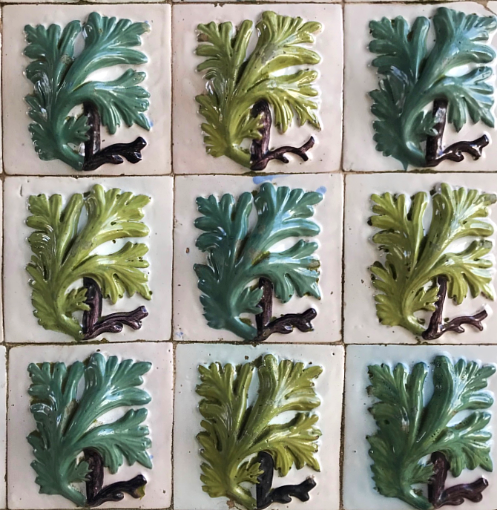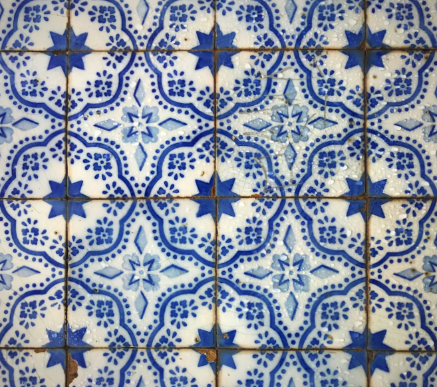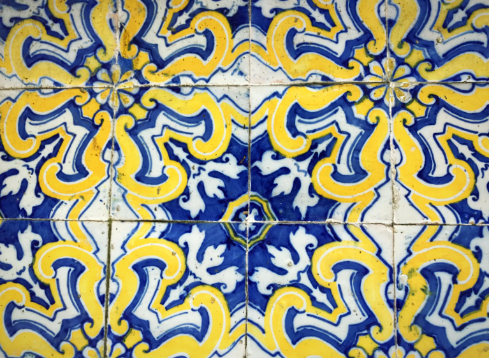"Elaborately-painted Portuguese tiles called azulejos,
fell out of favor in the early 20th Century.
But Lisbon today is embracing the art in its murals, museums and metro stations.
Azulejos first came to Portugal in the 15th Century, when parts of the Iberian Peninsula were still under Moorish rule.
Although many assume the word is a derivation of Azul (Portuguese for “blue”), the word is Arabic in origin and comes from az-zulayj,
which roughly translates as “polished stone”. Via BBC Travel to read more about Portugues tiles follow this link by clicking on it.
Up to the heavens, down to the ocean, covering walls, and above doorways,
Portugues tiles are there to greet with a history lesson, or to appeal to the creative side, also to remind us to cultivate richness in the simplest of things.
If I took a photo of every piece of tile I saw in Lisbon I would no longer have fingers for snapping photos all day.
Lisbon is a must on the places to visit.
After their introduction by King Manuel I, simple geometric shapes were replaced by more ornate decoration.
It was (and still is) typical for the Portuguese to tell stories about their history, religion, and culture through this decorative means;
they soon became pieces of public artwork." Via The Culture Trip to read more follow this link.
Places to see Azulesjos
"Museu Nacional Do Azulejo
While Portuguese azulejos are beautiful to look at, they’re even more captivating when you know about their history and symbolism. Visit the country’s national tile museum, Museu Nacional Do Azulejo, to discover the roots of tile making and explore a stunning exhibition of five centuries of azulejo trends, from Baroque to Art Nouveau. A highlight of the museum is a huge 23m cityscape of Lisbon, made up of 1,300 traditional blue and white tiles.
Sant'Anna Factory
Continue your history lesson by watching tile-makers at work at Sant’Anna Factory, where craftspeople use traditional methods from the 18th century to handcraft stunning ceramic tiles in a variety of styles and designs. After touring the workshop, visitors can browse the shop and purchase souvenir tiles or commission reproductions from the 17th and 18th centuries.
Fronteira Palace
Many of the most beautiful Portuguese azulejos in Lisbon can be found inside palaces such as Fronteira Palace, dubbed the ‘Sistine Chapel of Tilework’. The Room of Battles is particularly significant for its intricate scenes of wars and heroes – look up to see Venus, the God of love, standing with Minerva, the goddess of war. There’s also a large tiled deck, known as the Gallery of the Arts, which is covered in blue and white tiles depicting scenes from Greek mythology and decorated with statues of Greek Gods, such as Apollo.
National Palace Of Sintra
As well as being one of the oldest and most beautiful palaces in Portugal, the National Palace of Sintra houses one of the most striking tiled rooms in Lisbon. The ‘Room of the Coats of Arms’ is an artistic masterpiece. The walls are covered in extraordinary blue and white azulejos depicting scenes of historical imperial life, while the gold dome ceiling displays the coast of arms of the country’s most influential noble families.
Monastery Of São Vicente De Fora
Another fine example of Baroque-style blue and white tiling can be found at the Monastery of São Vicente de Fora. An unbroken tiled pattern winds throughout the entire monastery, from the entranceway and across the gallery to the indoor hallways and atriums. A total of around 100,000 tiles were used, making it the world’s largest collection of Baroque tiles.
Viúva Lamego
A former tile and ceramic factory that’s now a shop, Viúva Lamego is worth visiting for its exterior façade alone. The entire front of the building is covered in emblematic Portuguese azulejos depicting flowers, fruit trees, and animals. At the top, a pair of angels hold up the phrase ‘Anno 1865’, marking the factory’s opening year, while figurative characters stand guard by the doorways. Inside, visitors can shop for tiles, order motifs reproduced from 16th – 18th-century designs, or even commission custom orders for the ultimate souvenir."
Via Insider.Corinthina follow this link to see more
Yann and I went to Lisbon to celebrate our thirtieth wedding anniversary.
We stayed in the historical center at the Brown's Hotel
The hotel was what I sense Portugal has become a tangible mix of their rich culture brought to date without losing out to the cosmopolitan modernity that has influenced most of Europe, as well as an openness by blending old and new together in a unique artistic hip beautiful way.
Portugal is vibrant, colorful, spotless, delicious, it appealed to my five senses such a feast and includes its spirituality by being ultra kind and generous or Brandos costumes or Gentle ways as the Portuguese refer themselves.
Wherever we went English was spoken, I was amazed how fluent and ashamed that I only knew a handful of words considering my four grandparents, most my Aunts, and Uncles and my own parents spoke Portuguese fluently. As we walked along the streets snippets of conversation would caress me as I would recognize a word or two, then instantly with that be transported finding myself in the kitchen with my mother, or at mass with my Grandmother, or dancing with my cousins at a wedding. I felt the music of the language go deep into the roots of my being.
While visiting the crypt of Saint Anthony, The Igreja Santo Antonio, three soul-stirring moments took place:
1) As we were in the crypt a mass was going on, as I said in an earlier post, I was able to peek open the sacristy door just at the moment that the Priest was raising the chalice.
2) While at the crypt I said a prayer, "Saint Anthony you must know me as I pray to you often because I lose things. I must say without you by my side a great deal would be lost." I chuckled thinking how funny to start a prayer like that, but Saint Anthony is the Saint I was told to pray to as a child when I could not find something. Suddenly, I was awash with the sense to pray for patience as I often lose it when French Husband and I miscommunicate over the simplest things.
And then while there, I read: "In need of a partner? Then the tradition surrounding the statue of Saint Anthony is for you.
The tradition is that you will find a partner if you are able to throw and land a coin in the book of Saint Anthony on the statue in front of his church, the Igreja Santo Antonio.This tradition originates that Saint Anthony is the patron saint of lovers (and Lisbon) and this church was constructed at his birthplace." Via Lisbon Portugal Guide. Not that I want a new partner, but I NEVER knew Saint Anthony was the Saint of Lovers.
Our anniversary saint, or counselor.
3) As we left the crypt and walked out through the back of the church, the community was walking up to the altar and kissing something. I was intrigued and followed the others to the altar, in turn, each person was kissing a glass covered relic of Saint Anthony.
I think Saint Anthony is my new fav.
Between the colors, the intricate patterns, the lines going this way and that there is a graceful balance.
What is Saudade?
My Grandmothers, Aunts, my mom and my dad would often say, "No Saudade" when we cried or were sad. I found it comforting to hear them say that word with such gentle ease like an ocean wave, a wave of love going over me, While is Lisbon I saw the word "Saudade" often and wonder if my memory was correct so I looked it up:
"Saudade is nostalgy, it is a feeling of missing something or someone, it is quiet manners, so-called Brandes Costumes. Portuguese often can be seen somehow lost in their thoughts, looking towards never ending Ocean. They have some melancholy in them, always searching for something that can’t be found… something they once had and lost. Saudade could also be a synonym of pride."
Perched at the base of an urn, one foot planted the other foot in mid-air the bird reaches up to taste one of the berries.
"… A design has the capacity to communicate value and emotion in ways that escape written or spoken language. Even so, we can extrapolate elements of design through a culture’s use of language as a means of visual representation. At a recent showcase at Inform Interiors in Vancouver, Luis De Oliveira, founder and managing director of De La Espada, mused on the relationship between his country’s language and its contemporary design: “The Portuguese are a culture that is sensitive about certain objects.” The words for landscape and bridge, for instance, are grammatically feminine in Portuguese, whereas in French, Italian, and Spanish these terms are masculine. “We say we are a people of brandos costumes, of ‘gentle manners’,” says De Oliveira. He goes on to explain that, unlike in English, the word for thank you in Portuguese, obrigado, is an action. “Obrigado means that I am obliged to you, that I am bonded to you in some way.” This manner of being mindful seems to have permeated Portuguese design, including the spectrum of ways in which we relate to and interact with the spaces and objects that populate our lives."
The visit to Lisbon was a celebration of love past, present and well into the future.
I will post details of where to go, what to see, to entice you to visit in the days ahead.
xxx





Leave a Reply